English (Reading & Writing)
Curriculum Intent
Spa's reading curriculum aims to equip pupils so that they will:
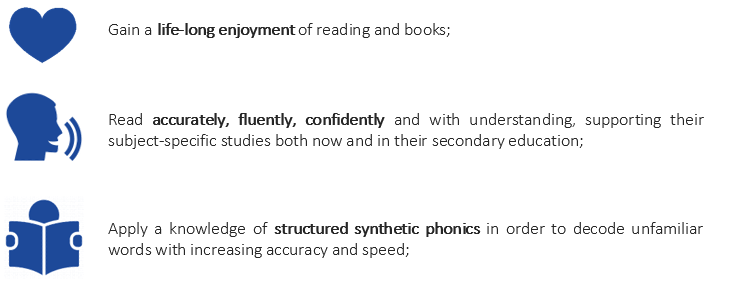
Spa's writing curriculum aims to equip pupils so that they will:
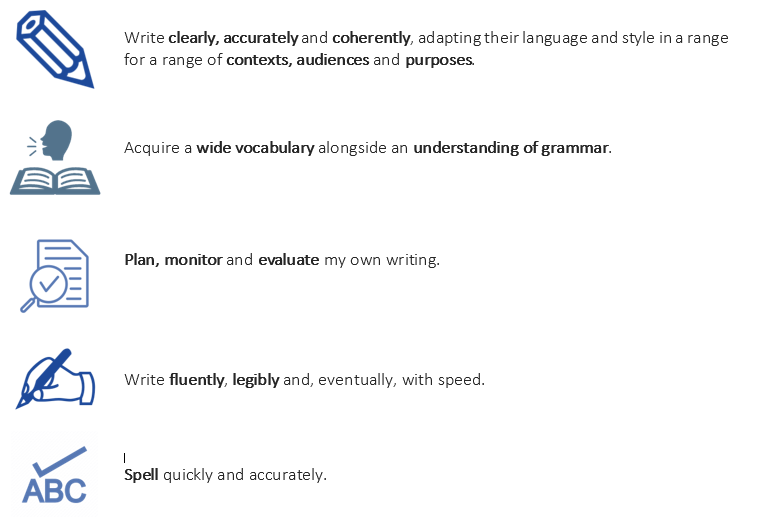
Spa's English curriculum, as part of our overarching curriculum model, is designed with our curriculum drivers in mind:
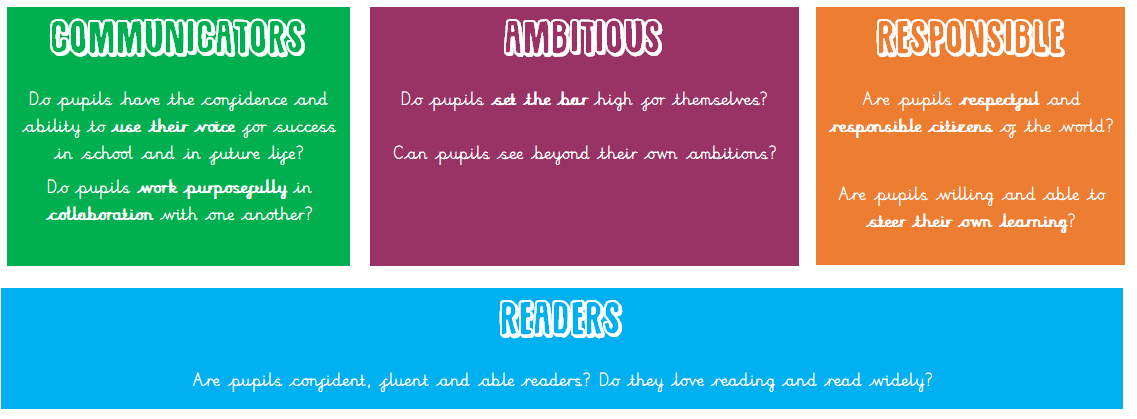
Curriculum Implementation
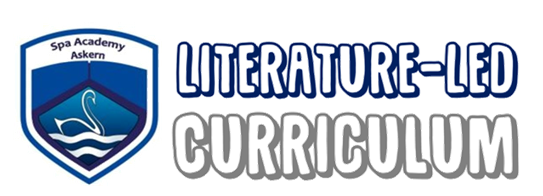
Early Reading
 Spa Academy Askern is determined that every pupil will learn to read, regardless of their background, needs or abilities. We aim to ensure all pupils, including the weakest readers, make sufficient progress to meet or exceed age-related expectations.
Spa Academy Askern is determined that every pupil will learn to read, regardless of their background, needs or abilities. We aim to ensure all pupils, including the weakest readers, make sufficient progress to meet or exceed age-related expectations.
We work collaboratively with our infant feeders to support the ambition that all pupils have mastered phonics in Year 2 (or before).
Transition
As the vast majority of our pupils come from two feeder infant schools, we work closely throughout Year 2 to ensure a smooth transition to the support your child receieves.
Both infant feeders use Read, Write, Inc as their phonics programme and we continue this support as pupils join us. In Year 3, those pupils that accessed Read, Write, Inc groupings will continue immediately in the same grouping, until reassessed within the first week of return.
We also work with Campsmount Academy who use Read, Write, Inc Fresh Start to support struggling readers in Year 7.
This strong transition on-entry ensures our pupils continue to receive support from the very beginning of their time at Spa.
Assessment & Identification
Year 3 pupils are assessed using Read, Write, Inc, triangulated with information from our infant feeders. Pupils accessing RWI Phonics are reassessed every six weeks (or more frequently) to ensure they are accessing phonics interventions supporting gaps in their knowledge.
Pupils that have moved beyond phonics are assessed termly (or more, if required) using STAR Reading online assessments. This provides us with a reading age, Zone of Proximal Development (see reading books, for how this links to book levelling) and a range of diagnostic information.
Where a pupil is identified as potentially struggling or falling behind, we further assess pupils for Read, Write, Inc Fresh Start.
Where progress does not improve, teachers work with the SENDCo to assess and plan for individual needs.
Intervention
 For pupils in Years 3 & 4 requiring additional phonics intervention, we use Read, Write, Inc. Phonics.
For pupils in Years 3 & 4 requiring additional phonics intervention, we use Read, Write, Inc. Phonics.
 For those pupils identified as falling behind in Years 5 & 6, Read, Write, Inc Fresh Start is implemented, with progress monitored regularly.
For those pupils identified as falling behind in Years 5 & 6, Read, Write, Inc Fresh Start is implemented, with progress monitored regularly.
Where progress does not improve, teachers work with the SENDCo to assess and plan for individual needs.
Additional support and strategies are implemented according to individual nee.
Reading Books
We aim to ensure that all children learning to read are given decodable reading books ‑ that is, books that are ‘closely matched to pupils’ developing phonic knowledge and knowledge of common exception words’ ‑ to read in school and practise at home. Pupils access RWI Phonics read and take home a copy of their latest read, with sounds and words they are familiar with. Similarly, pupils accessing RWI Fresh Start read and take home the anthology that is aligned with their current module.
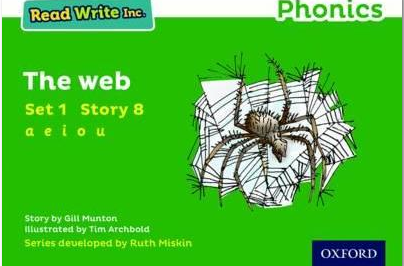
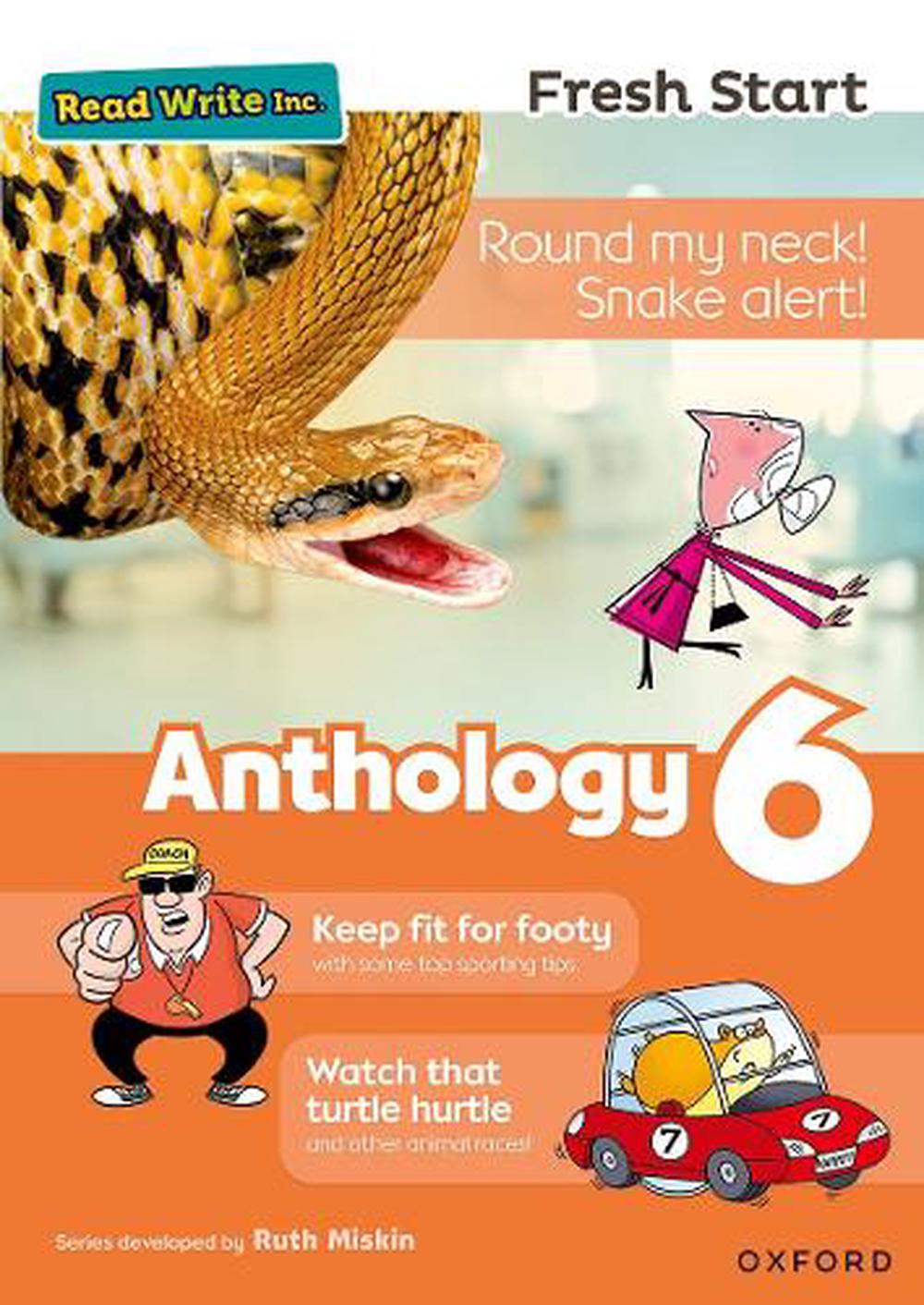
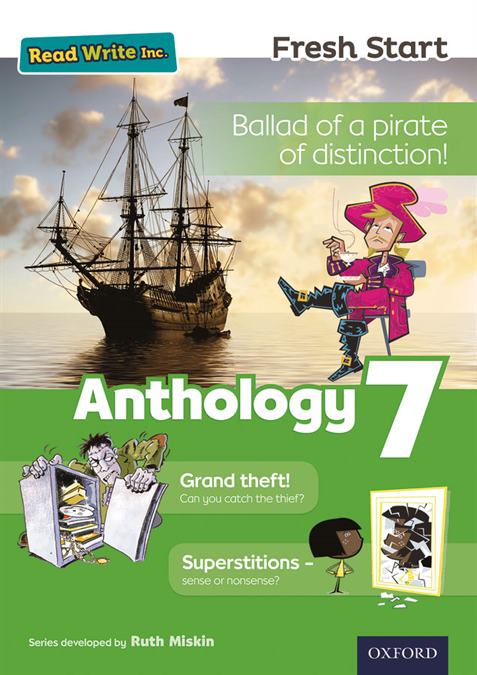
Where appropriate, pupils also use sound blending books, to support practise at home and school.
Whole-Class Reading
Pupils, who have moved beyond phonics, access whole-class reading.
Our curriculum details the skills that pupils will master in each year group. Our documentation also sequences in what order these skills are to be taught, ensuring that these are coherently planned over time.
What will pupils be taught?
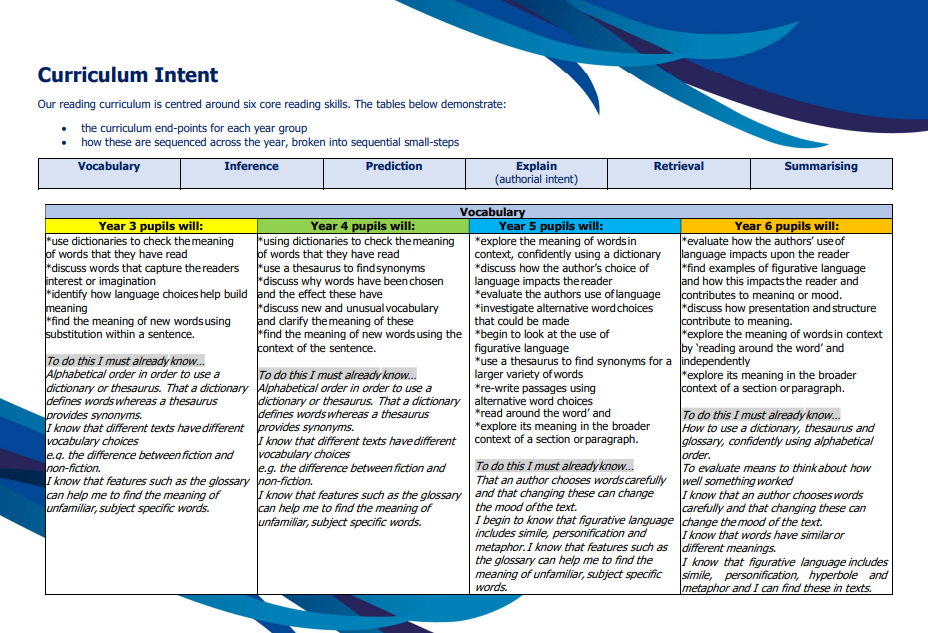
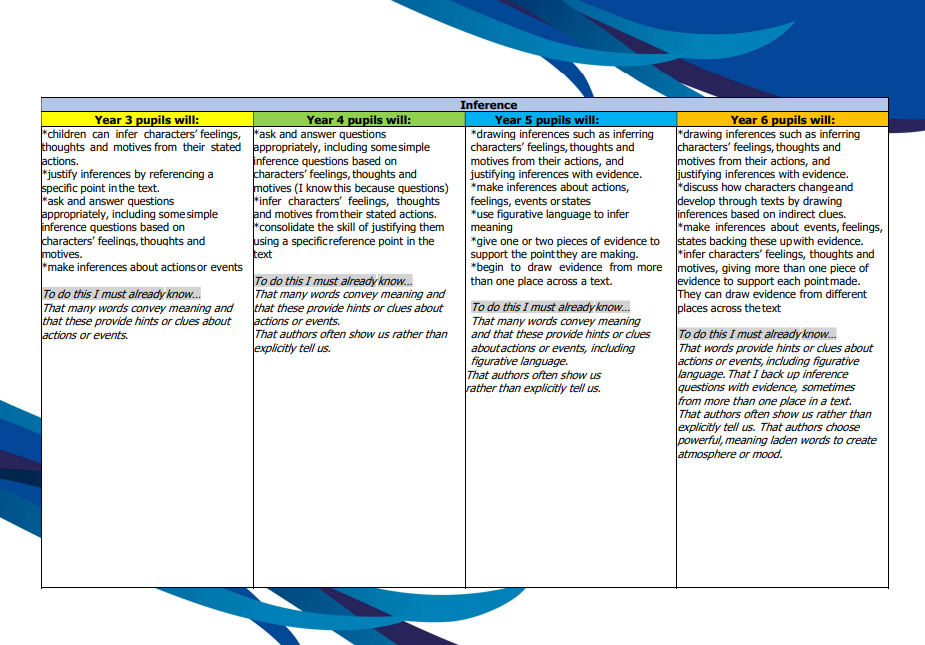
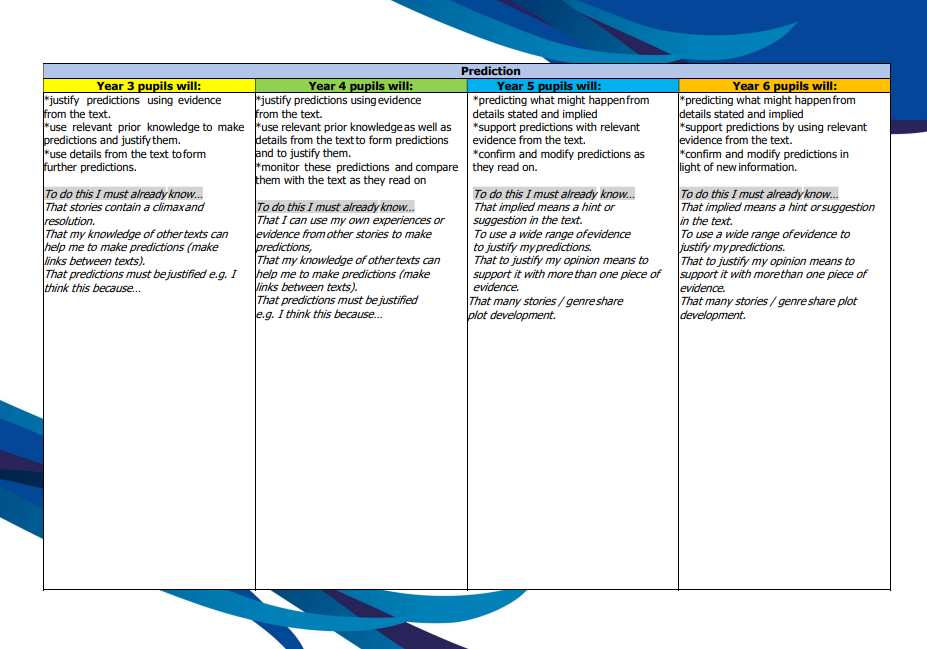
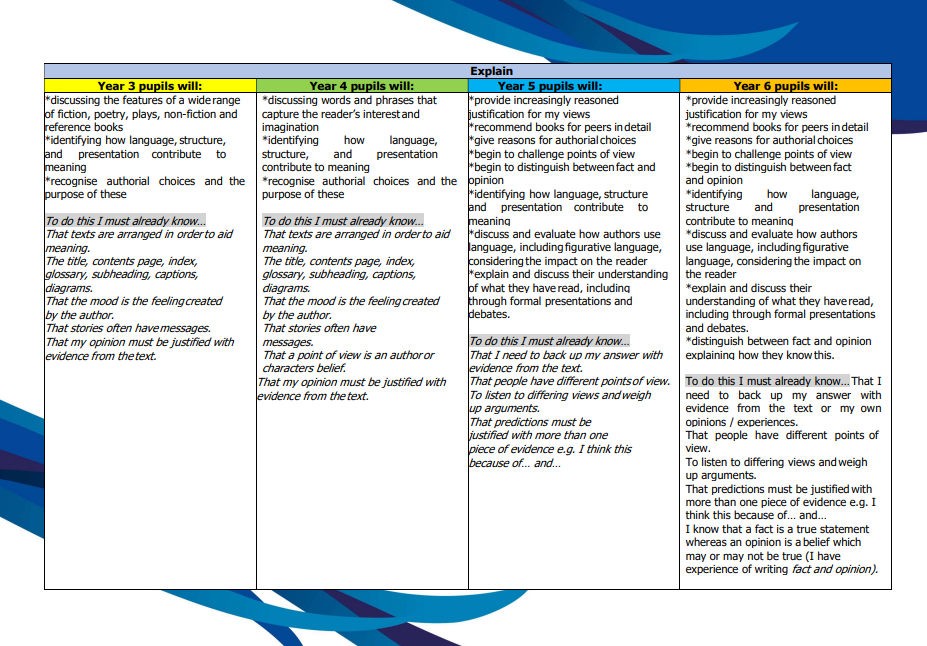
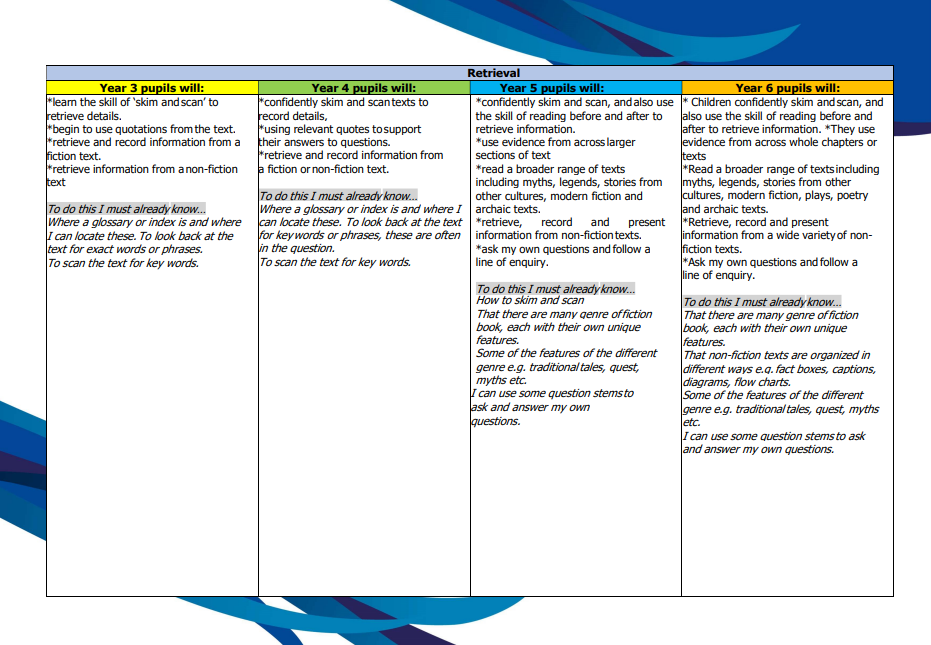
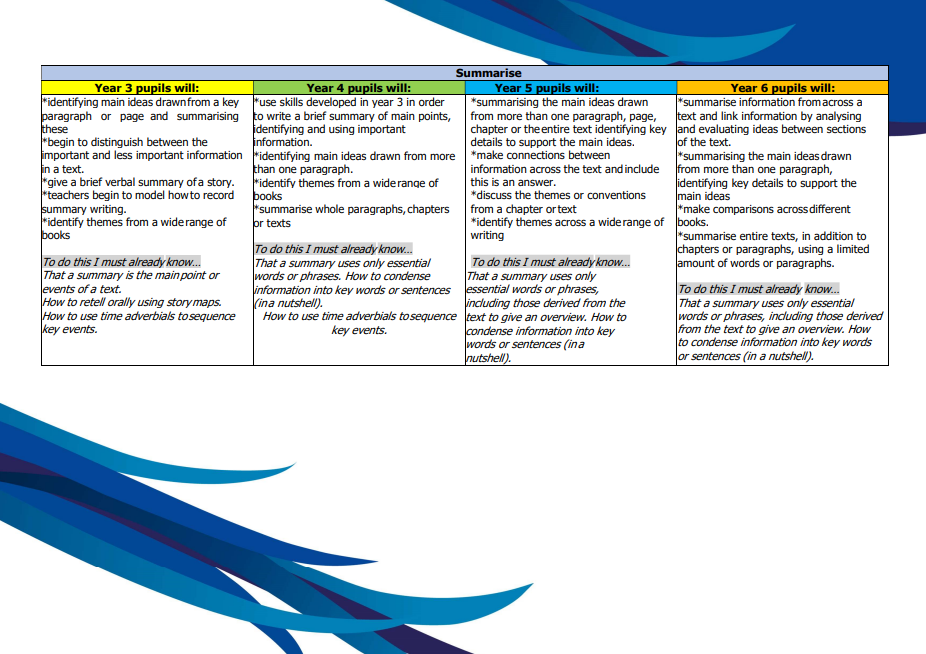
In what sequence will these skills be taught?
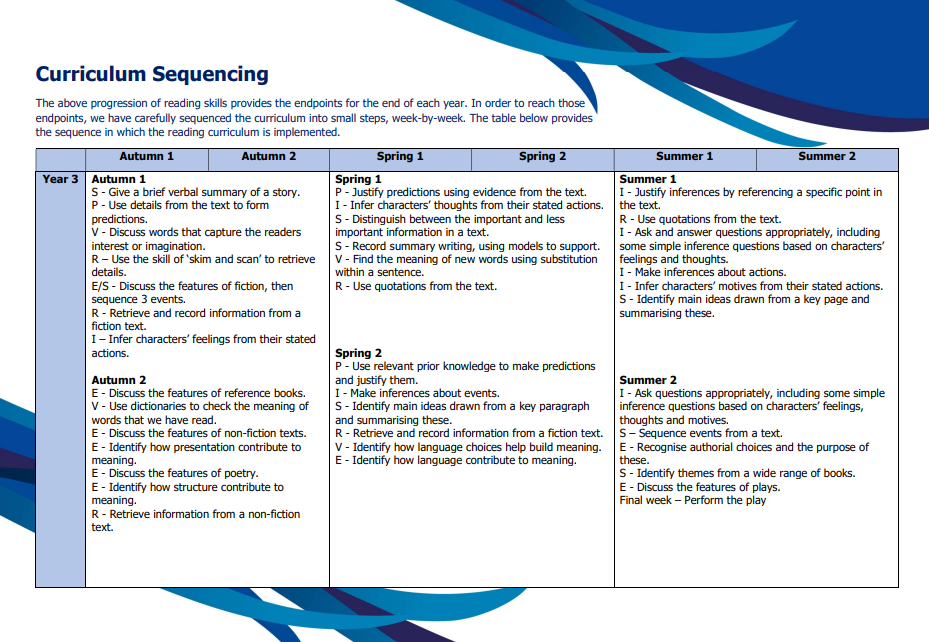
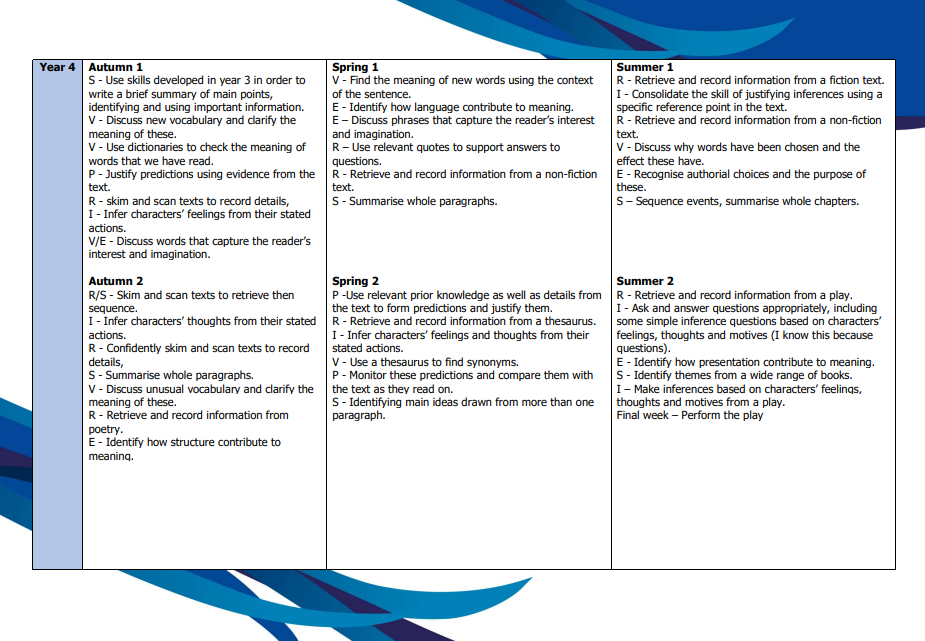
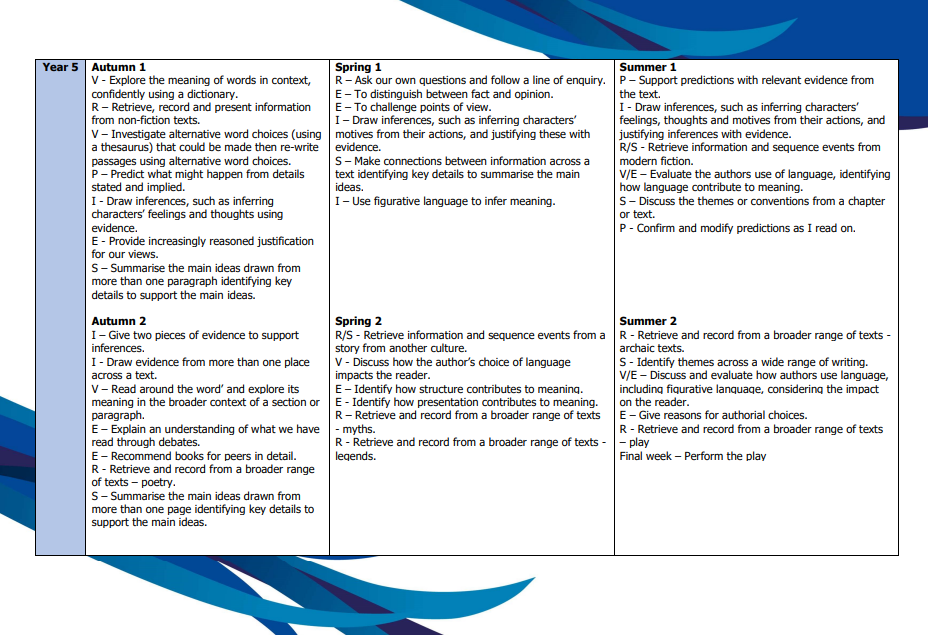
How will pupils be taught?
Spa's whole-class reading sessions mirror and builds upon practices from our Read, Write, Inc programme. This ensures that:
- Pupils continue to develop phonological awareness and automaticity;
- All pupils, including those who have accessed additional support with reading, have the same and familiar decoding strategies reinforced.
Writing Sequence
We have designed our writing sequence to help pupils to remember long term the content they have been taught and to integrate new knowledge into larger ideas.
Below is the sequence that is followed when teaching English:
Reading
Before pupils become authors of a piece of writing, they firstly read.
Pupils explore the novel text, or age-appropriate link texts, and develop their reading skills through a mix of direct instruction and independent practice.
Then, pupils begin to read as an author. Here, pupils develop their understanding and knowledge of the authorial intent in more depth, equipping them with tools, vocabulary and structures to apply in their own writing.
We will know:
- The definitions of key vocabulary
- Key information from the text
- How the author's choice of vocabulary impacts upon the reader
We will know how to:
In this stage of the English sequence, reading skills are taken from our Reading Curriculum.
Author's Toolkit
In this stage of the sequence, pupils are taught the key features of the text type.
We will know:
- The key features of the text type;
- How the features of the text type support the purpose of writing.
We will know how to:
- Distinguish between different text types;
- Identify features and similarities between other text types.
Apply
In this stage of the sequence, pupils are taught the grammar and punctuation relevant to their text type, building on their prior knowledge. Grammar and punctuation are taught explicitly, within the context of the writing.
We will know:
- The vocabulary for grammar/punctuation features
We will know how to:
- Use the grammar/punctuation being taught
Plan
We will know:
- The relevant information to be presented to the reader;
- A range of models for presenting information;
We will know how to:
- Sequence ideas in a logical order, reflecting the text type's features;
- Order information so that it meets the audience/purpose;
- Select relevant information, with an increasing understanding of audience/purpose.
For this part of the sequence, we use a range of models, dependant on the genre and purpose, such as those below.
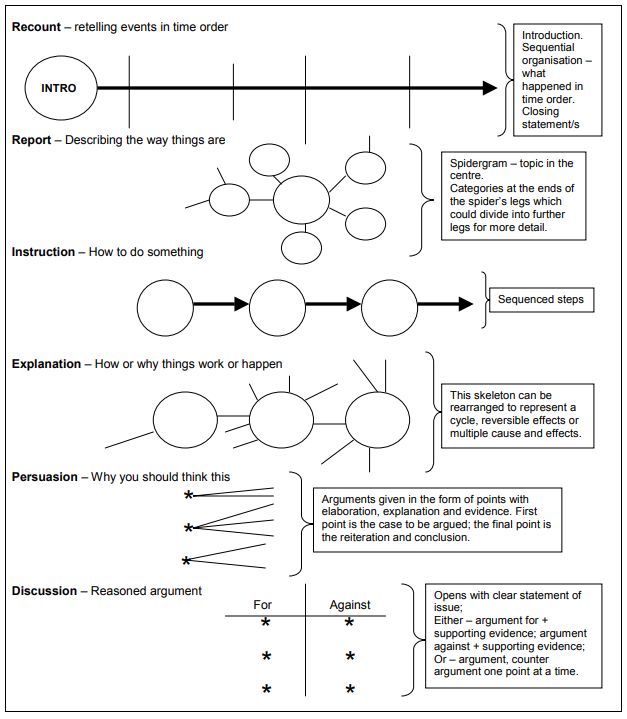
Write
Pupils are taught, through explicit modelling which draws together the above stages of the sequence, how to compose texts.
What literature do pupils study?
Our carefully-crafted, challenging and ambitious literature spine underpins our curriculum design. Why? Our pupils' future success is dependent on their ability to read with confidence and fluency. Pupils access these texts in their English sessions, their focused reading sessions and as part of a daily storytime. They have been carefully chosen for their:
- Challenge: we have selected texts with structures and vocabulary that provide a level of challenge to the relevant year group. Texts grow in their challenge over the year and as pupils progress through the literature spine.
- Challenging concepts: we have selected key concepts that, in the context of our school, we believe it is important to address and revisit with pupils, building an understanding of these over time. Many of these support the work of our ASPIRE curriculum, focused on pupils' spiritual, moral, social and cultural development.
Autumn 1 - Classic British Authors




Pupils will study, across the years, key texts from British authors. Pupils begin in Year 3 studying Ted Hughes' Iron Man. This aims to build on pupils' narrative knowledge from Key Stage 1. In Year 4, pupils study Lewis Carroll's Alice in Wonderland. This famous text provides opportunity for rich vocabulary and delving into using a range of devices to convey character and setting. In Year 5, pupils study C.S Lewis' The Lion, the Witch and the Wardrobe. In Year 6, pupils study J.K Rowling's Harry Potter and the Philosopher's Stone.
The selection of these texts purposefully allows pupils to acquire and, with increasing independence, apply a range of fantasy vocabulary and devices as they progress over the years. Texts in Year 5 and Year 6 are purposefully chosen as novels that are part of a series of texts, to encourage pupils to further explore these authors and their literature in our library.
Autumn 2 - Physical Geography




In Autumn 1 (the previous term) pupils will have studied geography discretely. By studying this geography in the previous term, the carefully-selected literature studied during Autumn 2 is accessible as pupils have already been exposed to the vocabulary and background knowledge required to comprehend.
In Year 3 pupils study The Great Kapok Tree. They are able to combine their geographical knowledge from Autumn 1's sustainability unit in exploring this tale of deforestation. In Year 4, as pupils have been previously exploring and comparing geographical regions, pupils study The Boy Who Biked the World. In Year 5, pupils are able to confidently enjoy The Explorer, having been equipped with the knowledge of this in Autumn 1. This adventure tale, studied in Year 5 is then built upon in Year 6, where pupils study Survivors. This series of short extraordinary tales builds upon pupils' understanding of natural disasters. It allows for critical study of conveying emotion and character through narrative.
Spring 1 - Picture Books




During Spring 1, pupils will begin reading Spring 2's historical fiction as their class novel.
In this term, picture books provide a stimulus for pupils' writing and reading link texts. Illustrator David Wiesner is first considered in Year 3's study of Flotsam. In Year 4, pupils explore Voices in the Park, providing a stimulus for both fiction and non-fiction writing. In Year 5, the creative mind of David Wiesner is revisited through using Tuesday as the stimulus for writing. In Year 6, building on the adventure-based literature of the previous term, pupils use The Man Who Walked Between the Towers as their stimulus.
Spring 2 - Historical Fiction




In Spring 2 (the previous term) pupils will have studied history discretely. By studying this history in the previous term, the carefully-selected literature studied during Spring 2 is accessible as pupils have already been exposed to the vocabulary and background knowledge required to comprehend.
Summer 1 - Mental Health, Disability & Neurodiversity

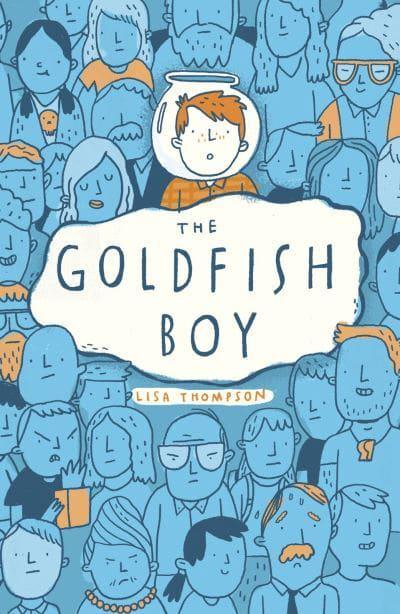


In Summer 1, pupils study literature focused on exploring mental health, disability and neurodiversity. Spa have selected this literature to build on our No Outsiders culture and work, focused on the protected characteristics. In Year 3, pupils begin to consider differences through The Day I Was Erased, and explore the work of Lisa Thompson. In Year 4, pupils revisit Lisa Thompson as an author in their study of The Goldfish Boy. Here, pupils begin to explore OCD. In Year 5, pupils study A Kind of Spark. This promotes themes of neurodiversity and celebrating differences. In Year 6, pupils study Ho-Yen's The Boy in the Tower. Pupils are encouraged to explore further reading on these themes through our diverse library selections and weekly No Outsiders assemblies.
Summer 2 - British Values



Literature in Summer 2 is based upon British Values. In Year 3 pupils explore democracy through The Accidental Prime Minister. Through the years after this, pupils' understanding of mutual respect is developed through exploring, in different literature, the experiences of refugees, a carefully-selected theme relevant to the context of our school. In Year 4 pupils study The Journey focused on developing an understanding of war and the many reasons and treacherous journeys of refugeed. In Year 5, pupils take an inward refection using The Boy at the Back of the Class, to consider differences and how we celebrate these in Britain and our own school. In Year 6, pupils study The Arrival which applies pupils' prior knowledge to an abstract tale of refugeeism. By sequencing the study of literature in this way, pupils are able to apply a range of devices and vocabulary with increasing confidence.
Seasonal Texts - leaving a 'reading legacy'
Seasonal texts - leaving a 'reading legacy'
 Alongside this core literature, we aim to ensure our pupils leave us having a love of two texts in particular. At Christmas, our school celebrates 'The Snowman', with writing and reading activities culminating in a celebration of this brilliant tale. We hope that, by celebrating this text each year, in a different way, pupils are able to retell this story to their own families in the future - creating a legacy of reading, not just a culture.
Alongside this core literature, we aim to ensure our pupils leave us having a love of two texts in particular. At Christmas, our school celebrates 'The Snowman', with writing and reading activities culminating in a celebration of this brilliant tale. We hope that, by celebrating this text each year, in a different way, pupils are able to retell this story to their own families in the future - creating a legacy of reading, not just a culture.
Spa's Reading Culture
Spa's reading culture is unavoidable: whether it's having a National Literacy Trust National Flagship Library in the heart of our school through to our celebration events, visiting book fairs our infamous library bus! Find out more about the many aspects of Spa's reading culture by clicking below.


Spelling
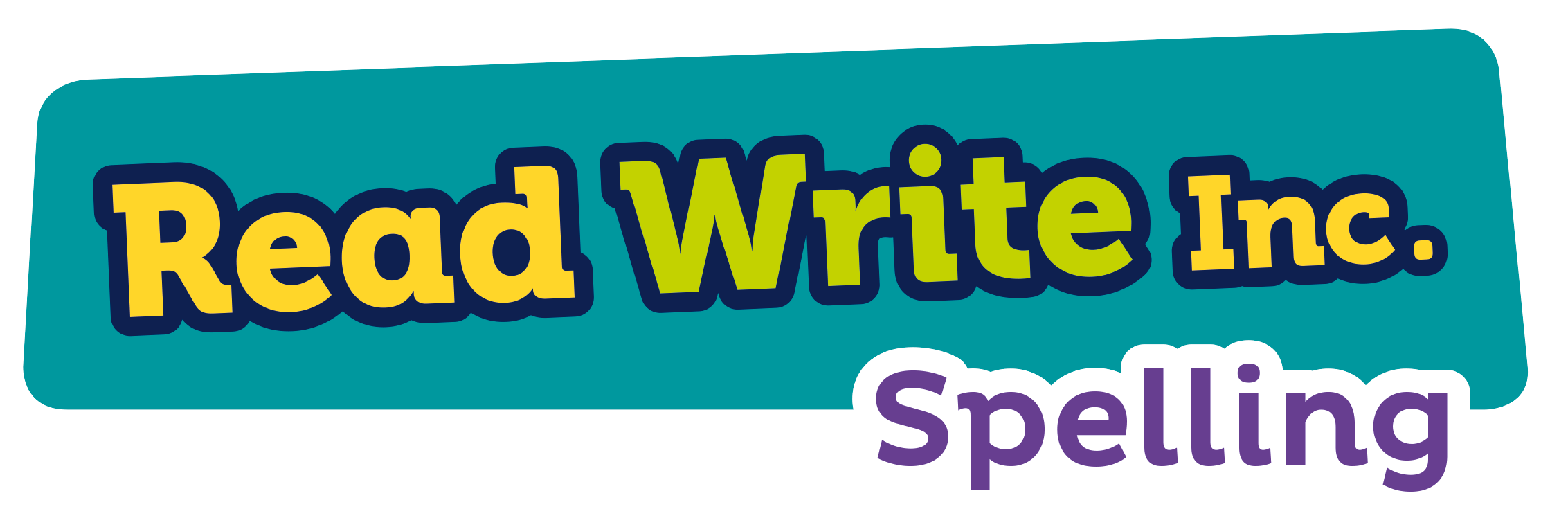 Read Write Inc. Spelling is used at Spa to teach cumulatively and systematically with deliberate, focused practice. It builds upon the teaching strategies and spelling activities from Read Write Inc. Phonics, the SSP that both our feeder infants and ourselves use to support reading.
Read Write Inc. Spelling is used at Spa to teach cumulatively and systematically with deliberate, focused practice. It builds upon the teaching strategies and spelling activities from Read Write Inc. Phonics, the SSP that both our feeder infants and ourselves use to support reading.
Handwriting
 Handwriting is taught through the Letter-join scheme. This focuses on sessions that work towards pupils writing fluently, legible and, eventually, with speed. Handwriting is prioritised to allow pupils to focus on composition.
Handwriting is taught through the Letter-join scheme. This focuses on sessions that work towards pupils writing fluently, legible and, eventually, with speed. Handwriting is prioritised to allow pupils to focus on composition.
Key Documents
Please find below the key documents referred to throughout this page.

